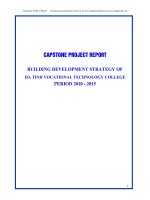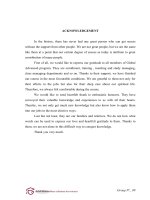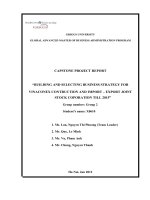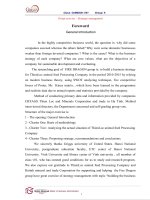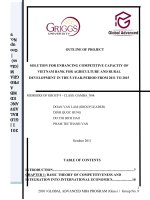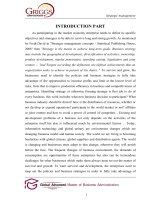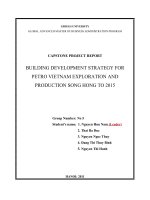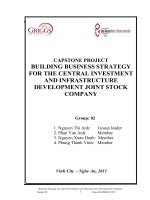Luận văn thạc sĩ quản trị kinh doanh quốc tế MBA (14)
Bạn đang xem bản rút gọn của tài liệu. Xem và tải ngay bản đầy đủ của tài liệu tại đây (724.91 KB, 114 trang )
ACKNOWLEDGEMENT
In the history, there has never had any great person who can get sucess
without the support from other people. We are not great people, but we are the same
like them at a point that our certain degree of sucess as today is attribute to great
contribution of many people.
First of all, we would like to express our gratitude to all members of Global
Advanced program. They are enrollment, training , teaching and study managing,
class managing departments and so on. Thanks to their support, we have finished
our course in the most favourable conditions. We are greatful to them not only for
their efforts in the jobs but also for their deep care about our spiritual life.
Therefore, we always felt comfortable during the course.
We would like to send heartfelt thank to enthusiatic lecturers. They have
conveyed their valuable knowledge and experiences to us with all their hearts.
Thereby, we not only get much new knowledge but also know how to apply them
into our jobs in the most efective ways.
Last but not least, they are our families and relatives. We do not how what
words can be used to express our love and heartfelt gratitude to them. Thanks to
them, we are not alone in this difficult way to conquer knowledge.
Thank you very much.
Group N0_ 09
CONTENT
LIST OF TABLES, DRAWINGS, AND GRAPHS...................................................iv
INTRODUCTION.....................................................................................................vii
GENERAL INTRODUCTION.................................................................................vii
CHAPTER 1................................................................................................................. 1
RATIONALE...............................................................................................................1
1.1. The necessity of marketing in business operation in general and foodstuffs in
particular.................................................................................................................................1
1.1.1. Some basic concepts of marketing:...................................................................1
1.1.2. The role, position of marketing in business operation:.....................................6
1.1.3. Content of marketing management:................................................................10
1.1.4. Factors affecting marketing activity of the enterprise:....................................11
1.1.5. Making plan for marketing activity in the enterprise:.....................................12
1.2. General concepts, matters and contents related to marketing strategy in the food
sector.......................................................................................................................................15
1.2.1. General concepts, matters and contents related to marketing strategy in the
food sector:........................................................................................................15
1.2.2. Contents related to marketing strategy in the food sector:...............................19
1.3. Theoretical models and strategies of marketing management in foodstuff industry.......21
1.3.1. The 4P marketing model:................................................................................23
1.3.2. The 4Ps combined model:...............................................................................25
1.3.3. The 4C marketing model:................................................................................27
1.3.4. The 7P model:.................................................................................................30
1.4. Research methodology.............................................................................................................30
1.4.1. Primary data collection method:.....................................................................31
1.4.2. Observation method:.......................................................................................31
1.4.3. Direct survey method:......................................................................................32
1.4.4. Mixed method:................................................................................................32
1.4.5. Applying the data method of the student group:..............................................33
1.4.6. Reason for choosing the research method:.....................................................34
i
Group N0_ 09
CHAPTER 2............................................................................................................... 38
ANALYZING THE REAL SITUATION OF...........................................................38
VIETNAM FOODSTUFF JSC.................................................................................38
2.1. General about Vietnam Foodstuff JSC..................................................................................38
2.1.1. Process of formation and development:..........................................................38
2.1.1.1. Introduction about the Company:........................................................38
2.1.1.2. Process of formation and development:...............................................39
2.1.1.3. Business profession and main products:..............................................40
2.1.2. Objectives and missions:..................................................................................40
2.1.3. Personnel structure and management machine of the company:...................43
2.1.3.1. Personnel organization:.......................................................................43
2.1.3.2. Management machine organization:....................................................43
2.2. Analyzing the situation and business production operation results of Vietfoods in 03
years from 2006-2008............................................................................................................45
2.2.1. The business production operation situation...................................................45
2.2.2. The business production operation results......................................................46
2.2.3. The effect of the business climate to the business production operation.........52
2.3. Analyzing the issues on construction and management of marketing strategy of the
company.................................................................................................................................53
2.3.1. The construction and deployment of marketing strategy in business of
Vietfoods:...........................................................................................................53
2.3.1.1. PLACE OF DISTRIBUTION:..............................................................56
2.3.1.2. PRICES:...............................................................................................59
2.3.1.3. PRODUCTS:........................................................................................59
2.3.1.4. PROMOTION:.....................................................................................60
2.3.1.5. PACKAGING:......................................................................................62
2.3.1.6. POSITIONING:....................................................................................63
2.3.1.7. PEOPLE:.............................................................................................64
2.3.2. Target market and product positioning:..........................................................67
2.4. Evaluation of marketing activities of Vietfoods, defining the existences of marketing
strategy of Vietfoods.............................................................................................................70
2.4.1. Marketing operation of Vietfoods:...................................................................70
ii
Group N0_ 09
2.4.2. Existences in marketing strategy of Vietfoods:................................................73
2.5. Analyzing the causes of existences stated above...................................................................80
CHAPTER 3............................................................................................................... 84
SOME SOLUTIONS AND RECOMMENDATIONS TO BUILD
MARKETING STRATEGY FROM 2010-2015 OF VIETFOODS........................84
3.1. General solutions in the Marketing operation of Vietfoods................................................84
3.2. Specific solutions in Marketing – mix (7P)............................................................................86
3.2.1. Solutions in product policy (P1- Product).......................................................86
3.2.2. Solution in price policy and price strategy (P2- Price)....................................87
3.2.3. Solution in channel of distribution strategy (P3- Place).................................88
3.2.4. Solution in promotion-communication (P4- Promotion)................................90
3.2.5. Personal solution (P5- Personal)....................................................................92
3.2.6. Solution in Process (P6- Process)....................................................................93
3.2.7. Conditional solution about material environment (P7- Physical Evidence)
...........................................................................................................................93
CONCLUSION..........................................................................................................95
REFERENCES........................................................................................................... 97
APPENDIX.................................................................................................................. 98
iii
Group N0_ 09
LIST OF TABLES, DRAWINGS, AND GRAPHS
LIST OF TABLES:
Table 2.1. Report on business production operation results of 2006 – 2008..46
LIST OF DRAWINGS, AND GRAPHS:
Figure 1.1. Theoretical model of marketing 4Ps.............................................26
Figure 1.2. the combination between model 4P and 4C..................................29
Figure 2.1. Sales revenue from 2006 – 2008 (Unit: Million dongs)...............52
Figure 2.2. Current product distribution model of Vietfoods..........................57
Figure 2.3. Product distribution model proposed by the research group........58
Figure 2.4. Some algae jelly products being for sale in the market................60
Figure 2.5. Aspects of human resources competence......................................65
Figure 2.6. the integration of human resources with the company strategy....66
iv
Group N0_ 09
FOREWORDS
In recent years, Vietnam economy has reached positive changes, from concentrated
planning and subsidized economy to market economy, step by step integrating into the
world economy. Especially, on November 7th 2006, Vietnam is officially admitted to be the
150th member of World Trade Organization (WTO) and on November 2nd 2007, Vietnam
became an official member of this Organization.
Transferring into market economy and joining into World Trade Organization of
Vietnam market has confirmed the integration of Vietnam into the world market, especially
in commercial field. Many economic policies need to be changed to make them suitable
with regulations of WTO. Researching and implementing of marketing activity not only
stops at concepts but also is analyzed and built to be an orientation, a strategy and by
enterprises because of the aim of maximizing their benefit.
When researching operation of market economy, we can see, marketing problem in
manufacturing and trading should be paid special attention to by business administrators. It
must be said that Marketing is the core point and key to the success of an enterprise.
Marketing strategy helps enterprise to have more flexible reaction in business.
Decisions in marketing activities shall incorporate with the survival and success of an
enterprise. The more suppliers are there in market, the more difficult business is.
Competition matter between companies and enterprises is becoming more drastic.
Considering in term of sector, if its competition is drastic, label competition is more
drastic.
Vietnam is a nation which has a long coastline that stretches along the North to
the South. Natural resources of sea have been exploring to serve the nation’s
economic development.
Many kinds of botanical species have been explored and processed into
product serving human life. One of marine botanies is gracilaria, it is processed into
algae jelly product, one type of product which is helpful to human health in current
life and industrial style.
v
Group N0_ 09
On Vietnam food market, many enterprises take part in producing algae jelly
product, such as: Vietfoods corporation, Long Hai Limited Company, Hai Ha
Confectionery Joint Stock Company, Huu Nghi Quality Confectionery Joint Stock
Company, Nghia My Limited Company, Tan Tan Food Company.
In such environment which has many producers and suppliers taking part in,
their competition in selling more goods and market share is unavoidable; that is
common issue of all enterprises.
However, how to sell more goods and have more market share is a separate
issue of each enterprise. In detail, each enterprise shall have it own marketing
strategy and method, way to implement that marketing activity then it will have
chance to reach its target.
After researching in Vietfoods Corporation (Vietfoods), with main product
algae jelly, trainees in group 9, class GeMBA01.E03 have chosen subject to
graduation exercise as follows: Building marketing strategy for the period of 2010
- 2015 of Vietfoods Corporation.
Due to limited knowledge as well as there are certain difficulties in time for
researching, surveying market and this exercise will not avoid shortcomings. With
spirit of promoting, we hope to have the contribution from teachers and trainees.
Trainees in group No.9, class GeMBA01.E03 would like to give our
sincerely thanks to teachers in Protection Board and teachers who give
lectures enthusiasm and help us during the MBA course and process of
implementing this subject.
Class: GeMBA01.E03
Group: N0 09
Nguyen Duc Duong
Chu Van Tien
Tran Van Thuong
Luong Quang Tuan
vi
Group N0_ 09
INTRODUCTION
GENERAL INTRODUCTION
1. Necessary of implementing this subject:
During studying process, trainees of MBA course have learnt much knowledge
of business administration. With collected knowledge and researching related
documents in field of business administration, they help each member in MBA
training course to have a new view and logic approach when trainee deals with
issues emerging during practice of production and business.
Trainees in group 9 would like to choose when doing this graduation exercise
is to build marketing strategy for enterprise, this is a new field even Vietnamese
economists also have just researched and applied into market in recent years.
Members in this group are staff working for electric power sector. Because of
Vietnam specific characteristics, currently competitive electric power sector
between electric suppliers still haven’t been established, so that the work of building
marketing strategy in electric power enterprise is still not specific. Therefore, the
group decided to research marketing strategy of other economic sector, in which its
product incorporates into market and consumer and it has to be subject to specific
pressure on competition.
During the last 10 - 15 years for world market and since 2005 for Vietnam
market, there has been appearance of fine powder processed products from algae,
these products has been more and more developing and replaced to a number of
traditional confectionary products which are used daily by users, especially in Tet’s
holiday. Algae jelly is characteristic product belonging to above product group,
which is processed from marina gracilaria, one type of marina product with its
advantages are to cool, good for digestion, good care and nutrition and it can
strengthen energy for human.
vii
Group N0_ 09
Currently, consumption demand of consumer to algae jelly product is large;
this product appears in many business places and is competitor that step by step
takes market share of other traditional confectionary products.
With these above characteristics, subject “building marketing strategy in
period 2010 - 2015 of Vietfoods Corporation” is suitable subject to requirement and
nature of marketing research.
From this subject, research group would like to express its information and
with enterprise to create new business capacity to help enterprise to have bigger
market share to its product; it is synonymous that enterprise shall increase its
revenue and benefits in the future.
2. Purpose of research:
Nowadays, customers are consider as easy to change person, they are always
have trend to find new things, and their ability of identifying, evaluating product
has improved much; they are persons who always pursue their passion. Marketing
may be the combination of these above factors.
To cope with and overcome challenges and pressures from customer, marketer
shall find the way to logically balance tools with marketing programs when starting
distribution of these products or service to consumers with reasonable price and on
time, at the right place and specific characteristics suitable to them.
Marketer shall be responsible for meeting changeable requirements of
customers about their hobby and priority, etc. when the economy increases or
decreases.
Algae jelly product is sold widely in the market with diversified origin,
produced by domestic enterprises and algae jelly product is also imported into
Vietnam from sub-section routes. From surveying and researching algae jelly
product of Vietfoods Corporation, researching group has found that products of this
Corporation have been faced up with strong competition on the market; besides,
products of Vietfoods corporation is not only the product which is dominant market.
viii
Group N0_ 09
From this research, trainee group would like to contribute its idea helping
enterprise to have views in different ways about marketing and to build its strategy
for product development in the period 2010 - 2015.
3. Method of implementing research:
To implement subject “Building marketing strategy in the period 2010- 1015
of Vietfoods Corporation”, implementation group agreed on using method of data
surveying then based on studied methodology basis to analyze and give comment,
evaluation and proposal.
Common principle to any process and decision making or in other words to
give any conclusion to any issue, it is necessary to base on real survey and combine
with academic methodology basis.
For marketing research, the above principle shall express clearer. Because,
marketing is understood as the way to incorporate market with customer; while
market and customer is concepts related to real situation, it progresses and changes
out of manager’s subjective thinking, it can be understood in emulation way that
manager can drive market and customer into planned way. Market and customer
progress according to a subjective principle to managers; however, it has organic
relation to managers, it effects decision of manager and on the contrary manager
also affects against market and customer. Impact of manager to market and
customer is to sell many goods with reasonable price to bring maximum profit for
manager. With these above target, manager impacts market and customer by: basing
on real survey of market and customer, manager give the best optimum decision to
reach manager’s target. With each manager, there are decisions in different levels,
depending on result of data analysis and capacity (knowledge) of each manager.
In conclusion, the way of research methodology, surveying, analyzing,
evaluating and proposing is suitable to subject “Building marketing strategy in the
period 2010- 1015 of Vietfoods Corporation”.
4. Structure of the research paper:
Structure of exercise is designed as follows:
ix
Group N0_ 09
Introduction: General production
Chapter 1: Rationale
Chapter 2: Analyzing the real situation of Vietfoods Corporation
Chapter 3: Solution and recommendation to build the marketing strategy
from 2010 – 2015 of Vietfoods
x
Group N0_ 09
CHAPTER 1
RATIONALE
1.1. The necessity of marketing in business operation in general and foodstuffs
in particular
1.1.1. Some basic concepts of marketing:
Many peoplemisunderstand marketing with selling good and consumption
stipulation activities; therefore, they think marketing is system of measures used by
sellers which help them to sell more goods and collect much more money.
However, modern marketing is defined as follows:
Marketing is promotion progress with market in order to meet demand,
expectation of human or marketing is one type of human activity with the aim of
meeting demand and expectation through exchange action.
In term of enterprise, marketing is one type of function activity which helps
the enterprise to reach target through exchange of goods on the market and on the
basis of meeting demands as well as expectation of target customer.
Demand is simply understood as the requirement of human about one
product. However, that term includes larger content if businessman doesn’t improve
his knowledge, he will no longer increase capacity of product consumption.
Demand is a term that its content includes three levels: natural demand, expectation
and payable demand.
Natural demand reflects the necessary of human about one type of product. It
is one type of human psychology, he will feel lack of something and can sense, it is
origin of all expectations and motivation of action. When natural demand appears,
human have two measurements: demand constraint or finding any way to satisfy
demand by finding object to satisfy demand, generally, they will select the second
option that is survival way of human.
Marketing can not create natural demand as well as create itself however,
marketing can find out natural demand. However, if marketing administrators just
1
Group N0_ 09
find natural demand of human and produce products which can meet human
demand then they will not spend a lot of time to think about that. With such type of
business, in this condition, benefits will reduce much, except enterprise’s product is
in monopoly position.
It is clear that the marketer can not stay in natural demand. In order to create
a product suitable with market demand, strengthen competitiveness and business
effectiveness, administrator shall understand second aspect of market demand that is
in expectation.
Expectation is a specific type of natural demand related to specific
conditions, specific features about all aspects of human such as learning capacity,
personal characteristics etc.. For example, hunger is a feeling of food shortage in
stomach, requirement of food and foodstuff to prevent hunger is natural demand of
human. However, everyone has their own hobby, may be you like to eat bread but I
like to eat rice… these differences are needed to satisfy by the same product but
have different features, reflecting human expectation.
Thus, expectation mentions here is the way to meet natural demand; main
demand is basis of expectation, expectation is specific characteristics of natural
demand. One type of demand that can toward expectations and therefore, toward
different types of goods because expectation always changes, it is diversify and
brings culture stamp and personal characteristics. Expectation usually towards to
specific product, only when enterprises find out consumer’s expectation they will
design product suitably supplying to market.
Natural demand and expectation of human is unlimited, businessman not
only discover and produce product suitably with us but also through exchange to
meet benefits of consumer and target of businessman. Therefore, when responding
natural demand and human expectation, businessman shall have to pay attention to
other contents of market demand that is payable demand.
Payable demand is direct exploitation object of marketing, because this is
real demand to bring which can bring turnover and earnings to enterprise. Payable
2
Group N0_ 09
demand is expectation of being supported by purchasing power and suitable with
payable ability of customer. It means that, consumer must have demand and payable
ability and will to pay.
In order to understand more market, it is requested that marketing
administrator shall have to research market and consumer about demand aspect.
Enterprises would like to success in trade competition and be trailblazer in meeting
and exploiting market demand and don’t want to be inactive position then the work
of researching and identifying in right way is one type of indispensable action
implemented regularly and actively by professional department.
In business, to have a real chance, it is necessary to measure commodity
supply demand about quantity and nature. To understand more market demand,
enterprises need to design product. Product is all types of goods and services that
can offer for sale and can meet demand or expectation of human, draw attention,
promote purchase and consumption of consumer. The biggest meaning of product to
consumer is that it doesn’t mean ownership of product but how it satisfied
consumer’s expectation and demand. Therefore, task for businessman is that he will
have to identify exactly demand and expectation of consumer and consumer’s
benefit needs to satisfy, from that, produce and supply the best goods and services
for consumer.
Many businessmen usually take mistake, that is, they just pay attention to
product itself and don’t care much product’s advantage to consumer. On contrary,
enterprises success in marketing implementation, usually work according to
philosophy: “love customer than product” or: “pay attention to benefit which can
bring to customer rather than product”
When the customers decide to purchase a specific product, they usually
expect benefit that it can bring to them. With the same demand, there are many
types of goods or goods brands to satisfy consumer demand according to each
customer sentiment, levels of goods benefit are not the same. This type of product
may have advantage of supplying this benefit but disadvantage in supplying another
3
Group N0_ 09
benefit. When deciding to buy any product, customer shall have to give option; to
give option, consumer shall base on capacity of supplying benefit and meeting
demand of each product.
Consumption value to one product is the valuation of consumer about its
ability in meeting consumer’s demand. Benefits that consumer expects are as
follows: material benefit, spirit benefit, social benefit and other benefits such as:
satisfactory, ease..., these are brought by not only products but also effort in all
production stages such as: selling, advertising, distributing products to customers in
person, after-sales service.
Evaluating consumption value for products is the first deduction of
customers to products. Customers are usually interested in expense before deciding
to buy products. According to customers’ concept, expense for a product is all loss
that they have to spend to have the benefits which brought by using period.
Therefore, in order to have consumption profit, customers must spend their money,
strength and even their expense because of repairing emerged consequences caused
by using period. These include both buying, using expenditure and eliminating
product. This is also the base for customers to choose different products in
satisfying the same need.
When customers can evaluate consumption profit and expense for each kind
of products, they already have their foundation to choose. Of course, customers will
choose which products can satisfy their need in its best condition. Satisfaction is
feeling level of customers originating in comparing results from consuming
products with their own expectations. Thus, marketing workers must learn from the
experiences, they are: to have their products sold easily, they need raise
consumption value and decrease using expense of customers and they shouldn’t use
dishonest marketing to develop their business such as: dishonest advertisement,
cheating in commerce,...
We can see, marketing appears when someone decides that their need and
hope are satisfied through exchanging. Exchange is an action of receiving expected
4
Group N0_ 09
product from someone by the way of giving them another thing. Exchange is the
most basic concept which creates the foundation for marketing activity; however, to
reach the exchange we must have following conditions:
- At least, we must have two parties.
- Each party must have something that is value with the other.
- Each party all have the ability to trade and transfer the thing that they have.
- Each party all have the right to accept or refuse the other’s offer freely.
Exchange is a process, not a matter, two parties are considered as performing
to exchange if they are bargaining to come to agreement. When they come to
agreement successfully, it is said that a transaction is completed. Transaction is the
basic measurement unit of exchange. Transaction is an exchange with commercial
nature between value things of the two parties.
As a result, commercial transaction is only truly taken place when have
enough following conditions:
- At least, it must have two valuable things.
- The conditions to perform the transaction have been already agreed.
- The time to perform has been already agreed.
- The place to perform has been already agreed.
These agreements can be showed in the commitment or the contract between
the two parties, base on a law system that forces each party to implement their own
commitment.
The concept of exchange, transaction leads us to the concept of market.
Market is collection of certain buyers who have certain needs and hopes that
enterprises can satisfy them, market includes present and latent buyers. Thus,
according to this concept, market’s scale will depend on number of people who
have the same needs and hopes, income level, capital amount that they willing to
spend to buy products to satisfy those needs and hopes. Market’s scale doesn’t
depend on the number of people who have different needs and hopes. Marketing
have the concept that sellers form supplying manufacturing branch and buyers form
5
Group N0_ 09
market. So, market term is used to refer to a group of customers who have certain
needs and hopes satisfied by a certain kind of product, they have their certain
gender characteristics or psychophysiology, certain age and live in a certain country.
Through above concepts, we can understand fully and correctly about
concept of marketing in common. From that, we can see the nature of marketing is
to gain the subject’s aim by the way of satisfying the object’s need. In term of an
enterprise, the nature of marketing is to satisfy the needs and hopes of market.
1.1.2. The role, position of marketing in business operation:
In term of history, the coming out into society of theory of modern
marketing and its applications is a process, that process associates to process of
seeking philosophies and methods of business administration direction to market. In
real life, it includes 5 philosophies or 5 viewpoints about orienting for enterprise’s
activities.
When the economy hasn’t developed or develops lowly, supplying hasn’t
met enough for demanding, manufacturing hasn’t met the consumption and
consumers’ need is still simple, the guidance point of view of businessmen is:
orienting to producing point of view. This point of view said that: consumers will be
interested in many products which are widely sold with low price.
Therefore, business administrator should pay attention to expand production
and consumption scale. It is said that key point decides the success of enterprise is
the number of product sold out and price level. However, the above point of view is
backward.
During period of 1920- 1930 of XX century, when economy grew and ability
of supplying product was better, consumer’s demand improved, and purchasing
power increased then opinion about perfecting product was established. According
to this opinion, consumer always likes high quality, multipurpose and multifunction
products. Therefore, business administrators want to success, they have to pay all
resources into creating the best quality product and improving it regularly. The
advantage of this point of view is to pay attention to customer benefit; however, its
6
Group N0_ 09
disadvantage is that it still doesn’t concentrate on customer demand and
expectation.
When economic sector develops because supply meets demand quickly result
in redundancy phenomenon then product consumption will be difficult because of
hard competition, view point about sales concentration is planted. This view point
said that consumers are usually self-opinionated and thus, they are rather afraid of
buying products. So that, in order to success, an enterprise needs to concentrate all
their resources and efforts into boosting consumption and promotion. However, this
viewpoint has a disadvantage that is it still hasn’t met demand and expectation of
consumer; it just pays attention to sales.
Between XX centuries, enterprises have to face up with hard competition and
demand changes, it is requested that supplier needs to sell things that market needs,
not only things it has, therefore viewpoint of marketing is established. The content
of the viewpoint is that: the key to obtain target of enterprise business is how to
identify right demand and expectation of target market, from which, enterprise can
find out solution that can meet demand and expectation by method having much
more advantage to competitor.
By the 1990s of XX century, the society had to face with problems such as
waste of natural resources; destruction of ecosystem, reduction of social standard
etc… then viewpoint of marketing of morality and society is established. According
to this point of view, enterprise task is to identify expectation and demand of target
market, and from that to satisfy demand and expectation by method more effective
to competitor and maintain or improve well-to-do living standard to consumer and
society. It is said that this has been the most advanced and modern viewpoint up to
now.
So that, enterprise needs to understand exactly marketing conception and
identify approach viewpoint when enterprise researches and applies marketing into
its business activity because it directly effects to enterprise direction. To success,
7
Group N0_ 09
enterprise has to have right direction, especially in competitive environment of
market economy.
From researching and analyzing development history of marketing,
economists confirm that marketing is established with the aim of assisting
effectively to trade activities, product consumption, dealing with enterprise’s
problems as well as identifying business opportunities, and from that, it can give the
best business solution to enterprise.
Marketing also has an important function that is to link all activities of
enterprise to market. Marketing directs administrator to answer two questions:
Firstly, whether market needs all products or buys all products produced by
enterprise or not?
Secondly, whether customer has enough money to buy product that company
intends to sell?
From that, marketing shall ensure enterprise’s market - oriented business
activities, and make enterprise understand more about market – demand and
expectation of customer and be mainstay of all business decisions.
Marketing is a basic function of business; it is important clue of united
management body in market economy. In general, function of marketing operation
in enterprise is that it always shows enterprise about these following contents:
- Who are customers of company? Where do they live and buy goods? Are
they male or female? Are they young or old? How much do they buy? Why they
buy company goods?
- Which types of goods do customers need? What do the characteristics of
these products? How about wrapping? Why do they need these characteristic? Are
current characteristics suitable to customer or not? What do advantages and
disadvantages of company product, compare to goods of competitive brand? Does
company need to change goods? Which factors and characteristics do company
change? What will happen if the company doesn’t change? What will company
cope with if the company changes?
8
Group N0_ 09
- How much price should company define? Why does company define that
price but not others? Is previous price level suitable or not? Should company
increase or decrease product price? When should company increase or decrease
product price? How much? Where? With whom?
- Should enterprises organize sales power themselves or base on other
forces? Who do enterprises base on? When should enterprise launch product out the
market? How many quantities?
- How to make product popular and customer like enterprise’s commodity?
Why does enterprise use this way but not others? How does enterprise introduce
general products to the public? Why?
- Do goods of enterprise need to have after sale service? Which type of
service is strong point of enterprise? Why? Why does enterprise select this type of
service?...
Those are the problems that beside the marketing functions, no other
functional operation of the company is responsible for answering, this reflects the
independent characteristic of the marketing function compared with other
management functions of the company. Of course when mentioning the above
content, the marketing manager cannot escape possibilities about finance,
production and technology, the skills of the human resource,... as between them
there is a relationship with one another.
For commercial enterprises, marketing commerce plays a specially important
role. Marketing commerce is understood as: “the process of organization,
management and controlling operations in order to create possibilities and reaching
the consumption target in the most efficient way the product of an organization on
the basis of satisfying in the best way the demand of the manufacturer, the trader
and the consumer”.
The purpose of marketing commerce is finally ensure possible profit of the
company when taking part in the business process in the market. But the direct
target of marketing commerce can be defined as to create the biggest opportunity to
9
Group N0_ 09
consume the product of the enterprise that through which, it can reach the profit
target. Marketing commerce is researched and developed in order to minimize risks
in commercial operations. The real situation of marketing commerce is to redefine
appropriately with the condition of the modern economy, the position of the
businessmen and customers in economic activity. From which, use synchronously
and scientifically the modern theoretical view points about organizations and
business administration in the process of approaching and win customers to
consume their products.
1.1.3. Content of marketing management:
Marketing management is to analyze, make plans, implement and test the
execution of necessary measures to establish and strengthen and maintain the
transactions beneficial to the buyers which have been selected to reach the target set
by the company.
The viewpoints of marketing management are basic ideology of marketing,
playing navigational role in marketing operation of the business, in order to meet
the demand and expectations of the customers and helps the enterprise comptete
effectively. There are 5 views of marketing administration and were presented in the
above part. Nature of marketing administration process includes 3 steps:
- Step 1: seeking and choosing value, that is researching and seeking
unsatisfied value and choosing supply value to meet demand of the customers.
- Step 2: creating value, seeking ideas on product design to meet demand and
expectations of the customers, fixing price suitably, designing distribution channels.
- Step 3: informing vale, implementing communication activities, choosing
suitable consumption forms, implementing customers’ service
Marketing administration process includes 5 following steps:
- Step 1: analyzing marketing opportunities
- Step 2: Fragmenting the market and choosing the target market
- Step 3: Making plan for marketing strategy
- Step 4: Making marketing program
10
Group N0_ 09
- Step 5: Organizing the implementation of control (and adjusting if any)
1.1.4. Factors affecting marketing activity of the enterprise:
Marketing activity of any enterprise is influenced by many factors which
create business environment of an enterprise. The environment is approached under
the angel in which marketing is marketing environment.
Marketing environment is synthesis of all factors, forces inside and outside
the enterprise, having positive or negative influences on operation or decision
making of the marketing division in the enterprise, affecting capacity of establishing
or remaining relationship between enterprise and customers.
Changes of the marketing environment have deep and strong influences on
enterprises. They are both good and bad. Environment does not only have gradual
and easy changes, developments to be detected and forecasted but it also has
immeasurable changes, even shocks.
Thus, marketing environment creates both favorable opportunities and
pressure, threat to all businessmen. The basic thing is that they must know to use
marketing study tools, marketing systems to monitor, catch and solve flexibly
marketing decision to adapt to changes from the environment.
Marketing environment is the collection of micro and macro marketing
environments. Micro marketing environment includes factors closely related to the
enterprise and affects capacity of the enterprise when serving customers. They are
internal factors of the company, marketing channels, customer market, competitor,
supplier, intermediary institutions, etc. These factors have direct influences on the
operation of the enterprise which also has certain influences on these factors.
Macro marketing environment includes widely social factors, forces, they
have influences on the whole micro marketing environment and marketing
decisions of the enterprise. Macro marketing environment collects all the factors
which cannot be controlled and changed by the enterprise, this is the origin of
arising opportunities and risks for the enterprise. Those factors belong to population
11
Group N0_ 09
studies, economy, nature, technique, technology, legal politics, morality and social
culture, etc.
1.1.5. Making plan for marketing activity in the enterprise:
a. Marketing strategy:
To remain the development, every enterprise has to look forward with
objectives need to be achieved and ways to achieve them. Today, management
depending on experiences, intuition and sensibility cannot ensure for the success of
the enterprise. Thus, it is necessary to establish a strategic plan and develop it for
total activities of the enterprise.
Strategic plan helps the enterprise realize more clearly the direction
objectives, coordination of activities become more perfect. At the same time, it also
helps administrator think business problems systematically, bringing better changes
to the company, enterprise.
Strategic plan of the company is a business administration doctrine, being
foundation for making business strategy to ensure development and remain strategy
adaptation between one side which is objectives and capacity of the company and
the other side which is changing market opportunities.
Thus, strategic plan making process of a company is the reflection of
learning and identifying external factors, environment, evaluating conditions and
internal capacity of the company to draft strategic plans to achieve a certain
objective.
b. Marketing planning:
Marketing planning is the process of analyzing, making plan, organizing
implementation and checking marketing programs to each target customer group
having specific demand and expectations.
So, marketing planning has following significant features:
Firstly, marketing planning is a process including: analysis, plan making,
implementation organization and check.
12
Group N0_ 09
Secondly, marketing planning is implemented for each target customer group
with certain demands.
Thirdly, each target customer group have their own demand and expectations,
thus, it can be understood that marketing planning is set with each separate goods,
specific market.
c. Analyzing current market and marketing strategy:
Analyzing current market and marketing strategy aims to evaluate main
characteristics of the market such as scale, structure, changing tendency and
influences of marketing environment to the shopping of customers. One more time,
contents of environment analysis are mentioned and accessed to determine position
of the company at present. However, this analysis must fix to each specific product.
At the same time, the company also needs to analyze competition as: determine
competitors, their market share and strategies. When analyzing the current
marketing strategy, component strategies of mixed marketing will be reviewed.
Specifically, the company will approve product in terms of revenue, price and profit
of main products, contents in the strategy on price, sale distribution and promotion
will be also reviewed in the new situation.
d. Analyzing chances and risks:
From the analysis of environment and market, chances and threatening risks
are identified and determined. Chances may open to new development possibilities
if the company can take advantage. Risks, threats need to be identified to have
measure to minimize and prevent.
e. Determining marketing objectives:
On one hand, marketing objectives must be consistent and oriented from
objectives of the strategic plan, on the other hand, these objectives should be
established clearly, specifically and measurable. Thus, objectives of marketing plan
are often: sale, profit and market share need to be achieved, quality and outstanding
characteristic of the product, price, service, position of the enterprise. Commonly, a
marketing plan may have many objectives which may not be consistent and have
13
Group N0_ 09
different importance, thus, we need to arrange them in an order in the process of
implementing according to their importance.
f. Choosing target market:
Based on results of analyzing market environment, current marketing
strategy of the company and target mission that the company wants to achieve,
nature of target market choosing is choosing potential customer groups that the
company will serve with certain products. Selected target markets can be one or
several main market fragments or total market.
When choosing target markets, we need to make following matters clear:
- Type of product which will be sold to satisfy customers’ demand.
- Way to satisfy that demand
- Growth scale and potential of the market
- Sale capacity and profit collection
- Conformability level between customers’ demand in selected markets and
capacity to satisfy that demand.
Depending on analysis, evaluation of matters above, the company will
choose best potential markets, which are considered as objects of marketing plan.
g. Establishing marketing - mix
Marketing – mix is a collection of variables that the company can control and
manage and it is used to achieve influences and affect target customers beneficially.
Component parts of marketing – mix are known as 4P: product, price, place,
promotion strategy.
- Product strategy: is the determination of product category, type, its
characteristics such as its name, brand name, technical features, package, size and
service after sale.
- Price strategy: is the determination of price strategy objective, selecting
assessing methods, price strategies of the company.
14
Group N0_ 09
